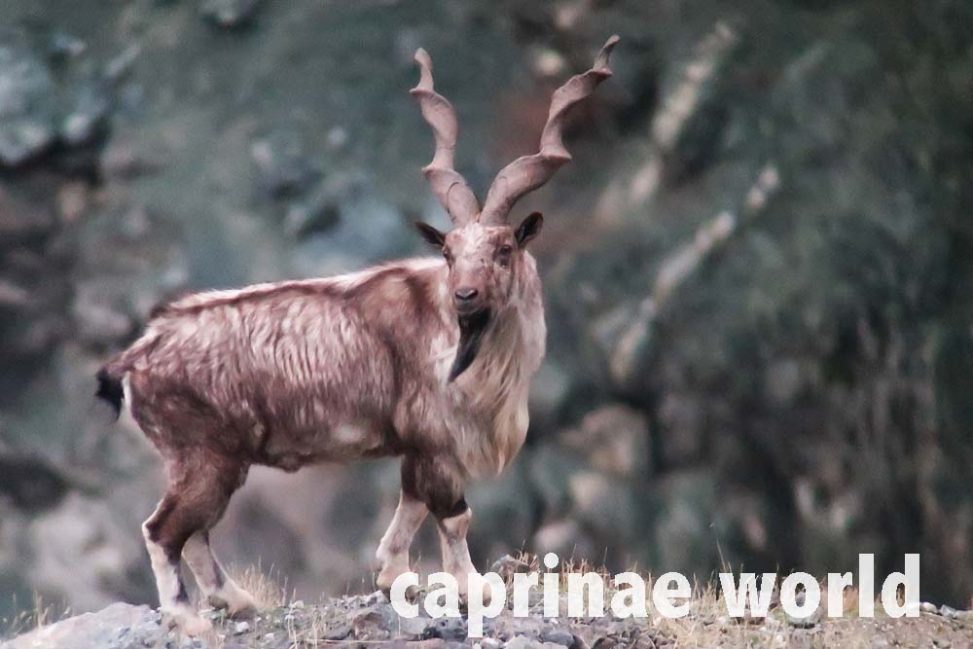Body dimensions and weights given by Heptner (1966) suggest that the Heptner’s Markhor is one of the smaller Markhor phenotypes.
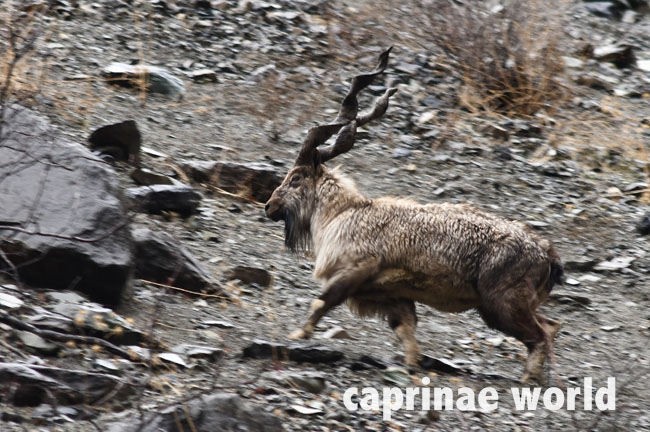
Names
English: Heptner’s Markhor, Turkmenian Markhor, Uzbek Markhor, Russian Markhor [1], Bukhara (Bokhara) Markhor, Tajik Markhor [1, 2]
Choice of name: Bukhara – also spelled Buchara or Bokhara – is a city and the name of a region in Uzbekistan. Lesser-known: It is also the name of a former emirate, that existed from 1785 to 1920 in what is now modern-day Uzbekistan and Tajikistan [wikipedia]. The boundaries of the former emirate encompass the distribution range of the Heptner’s Markhor. Otherwise it seems not justified to name a taxon that occurs in various countries after a location in one of these countries. We therefore prefer the taxon name „Heptner’s Markhor“. Wladimir Georgiewitsch Heptner was a Russian zoologist. Zalkin, who described the subspecies, honoured Heptner by using the name: Capra falconeri heptneri.
German: Heptners Markhor,
Buchara-Markhor, Turkmenische Schraubenziege [7], Bucharische Schraubenziege, Marchur [5b], Bucharaschraubenziege [2];
French: Markhor de Bokhara [2], Markhor de Bukhara [1]
Spanish: Marjor de Bujara [2], Markhor de Bukhara [1]
Other scientific names and synonyms: Capra falconeri ognevi, Tsalkin 1945 [2]
Distribution
by country/state: Afghanistan, Tajikistan, Uzbekistan, Turkmenistan
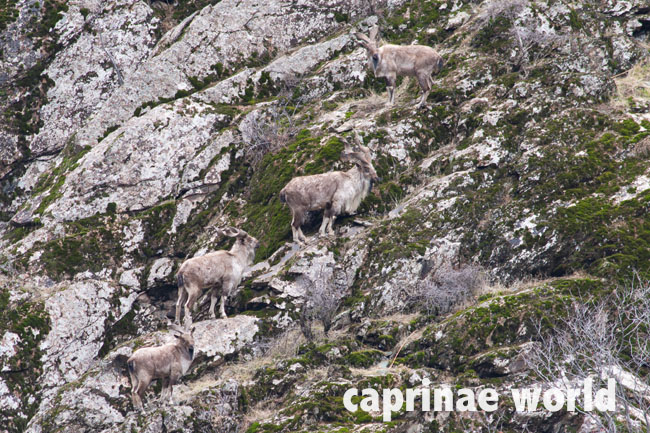
This subspecies previously occupied most of the mountains lying along the banks of the Upper Amu Darya and the Pyanj Rivers from Turkmenistan to Tajikistan. Currently, it is found in only two or three scattered populations and its distribution has been greatly reduced (Weinberg et al. 1997). The subspecies was confirmed to occur as well in Afghanistan on the bank of the Pyanj River (Moheb and Mostafawi 2011, 2012). [6]
Afghanistan: Almost nothing was known of this subspecies or its distribution before 1979 (Habibi 1977). Reconnaissance surveys and interviews with villagers have shown that, across from the two strongholds of Markhor in Tajikistan, this subspecies exists but in very low numbers in the Darwaz Region (Kof Ab district, ~ 38°02’ N, 70°23’ E) of Badakhshan Province, and in Shahr-e Buzurg District and neighboring Chah Ab District of Takhar Province (~ 37°31’ N, 70°02’ E). The Markhor seem to cross the Pyanj River (which forms the border between Afghanistan and Tajikistan; Moheb and Mostafawi 2011, 2012). [6]
Tajikistan: Limited to the region along the Pyanj River east of Kulyab, southern Hazratishoh range (~ 70°05′ E and 37°54′ N), including the Kushvariston massif (~ 70°03′ E, 37°35′ N) and the Pasi Parvor mountains (~ 70°16′ E, 37°44′ N), and the eastern slope of the southwestern edge of the Darvaz range (~ 70°21′ E, 38°05′ N, Shuroabad district of Khatlon Region and Darvaz district of GBAO Region). Formerly markhor were reported from the Babatag Mountains (~ 68°03′ E, 37°46′ N) at the border with Uzbekistan (Ishunin 1972) and from the Sanglak and Sarsarak Ranges (southern parts of the Vakhsh Range, ~ 69°7′ E, 38°13′ N) (Abdusalyamov 1988). No recent reliable information suggests that Markhor still exist in the Babatag (Michel et al. 2014). The presence of Markhor in the Sarsarak Range was confirmed in 2014, but the species has been extirpated from the Sanglak Mountains (Khalil Karimov, Panthera, pers. comm. 2014). [6]
Uzbekistan: found in the Kugitang Range (~ 66°36′ E, 37°48′ N) at the border with Turkmenistan. Its occurrence was reported in the middle of the 20th century from the Babatag Range (~ 68°03′ E, 37°46′ N) at the border with Tajikistan (Bogdanov 1992). [6]
Turkmenistan: restricted to the western slope of the Kugitang Range (~ 66°31′ E, 37°49′ N), bordering Uzbekistan (~66°40’ E, 37°30’ N; Weinberg et al. 1997a). The population of the Turkmen (western) slope appears to be larger than that on the steep eastern (Uzbek) slope. [6]
Description
Body dimensions and weights given by Heptner (1966) suggest that the Heptner’s Markhor is one of the smaller Markhor phenotypes.
length / head-body – males: 161-168 cm; females: 140-150 cm (Heptner, 1966) [5b]
shoulder height: 86-89 cm – reaching up to 100 cm [5b]
weight – adult males: 80-86 kg – reaching up to 100 kg; adult females: 41 kg – reaching up to 50 kg [5b]
ears: pointed [2]
life expectancy in the wild: 10 years and more [5b]
diploid chromosome number: 2n=58 [2]
Colouration / pelage
The pelage of the Heptner’s Markhor is similar in colour than that of the Straight-horned Markhor.
winter coat of males: long, shaggy hair grows behind the dark beard, from the chin, neck and forequarters. The dorsal region is usually darker grey with this colour extending onto the haunches. The flanks are of a somewhat lighter grey. The dark hairs on the back and flanks are intermingled with whitish hairs in some animals, giving them a speckled appearance. [2]
summer coat: a reddish pelage with yellowish-buff tones; with some lighter coloured, creamy areas on the chest. The mane is less voluminous and shorter, restricted mostly to the upper and middle parts of the neck; straw coloured behind the dark beard. [2]
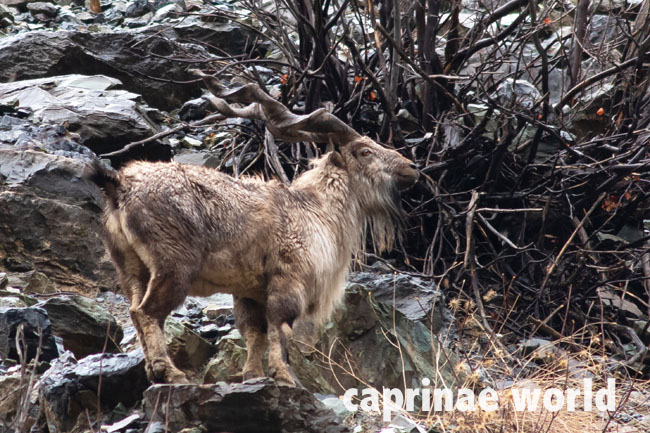
females: more uniformly coloured – greyish brown, with some darker areas on the brisket. The face is somewhat darker than the body. [2]
animals from the Kugitang Mountains: have a somewhat lighter overall pelage colouration in winter [2]
mane in winter: The long hairs growing on side of the neck, bib, brisket and upper parts of the forelegs are reddish to straw-yellowish, intermingled with some grey, and may reach down almost to the hocks. [2]
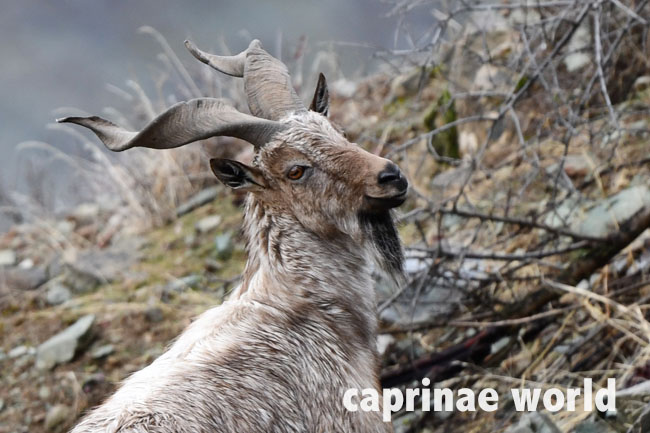
legs: below the fetlocks whitish, with a black stripe on the front; inner parts of the limbs are dirty white. There is also lighter coloured, shaggy hair growing from the frontal part of the hind legs. [2]
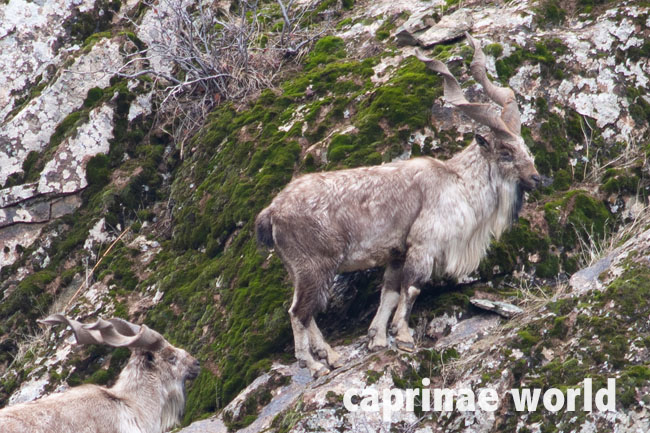
belly: dirty white [2]
face: reddish-grey above the muzzle, turning darker grey intermingled with whitish hairs, on the forehead. In older specimens the forehead may be of a greyish-white colour. The area around the eyes and the lower parts of the jaw are greyish-red. [2]
tail: black [2]
Horns
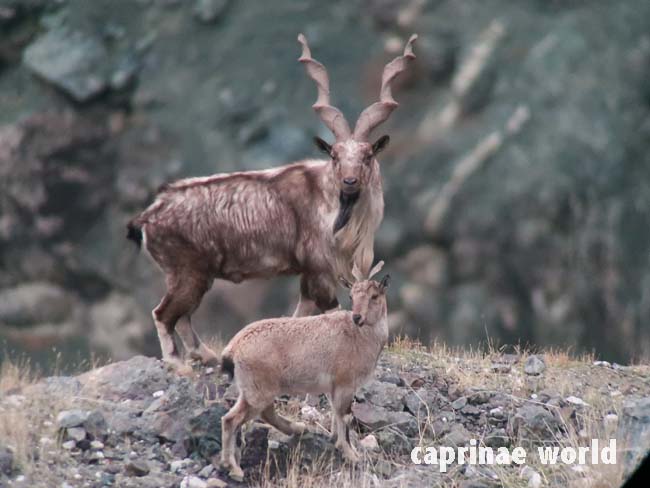
The horns are rather straight, narrow and with a massive, heavy spiral. Occasionally there is some flare. They show the form of a very open corkscrew pattern with only a few twists and have very prominent keels. The twist is not as tight as that of the Suleiman Markhor. Very often the tips of the horns appear somewhat broomed, especially in older specimens. [2]
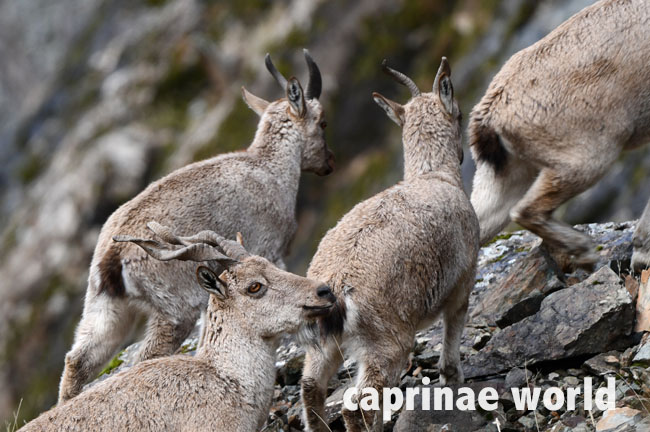
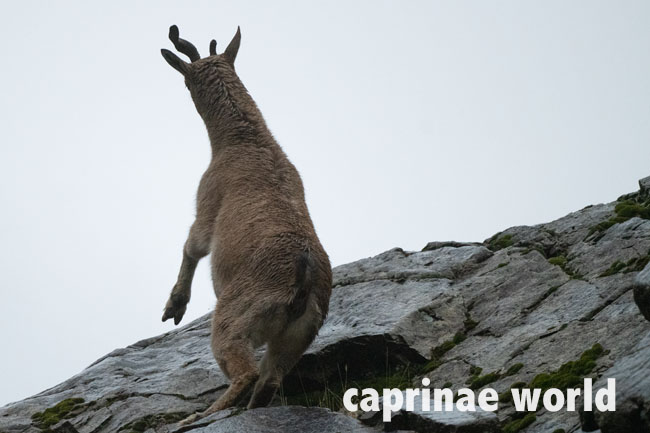
Table 1: Some horn measurements from recorded trophies from the Kugitang Range in Uzbekistan and Turkmenistan, harvested 1992-2000 [2]
| longest horn recorded: | 108,0 cm (Uzbekistan, 2000) |
| median horn length: | 81,9 (n=10) |
| basal circumference: | rarely exceeds 25,4 cm |
| median horn circumference: | 25,1 cm |
| horn spread: | 48,9 cm (n=1) |
Habitat
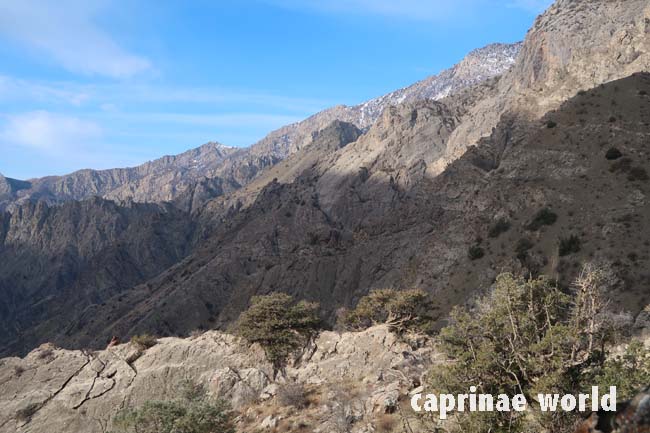
In the Kugitang Mountains most of the Markhors occur between 1500 and 2500 metres ASL. But the animals seem to avoid dense shrubbery with juniper. They are most abundant in the slopes of deep gorges with rocks and meadows with steppe vegetation, including grass, herbs and scattered bushes. Some animals, in particular adult males, are to be found in alpine areas during the summer – 3000-3500 m (Sultanov, 1953). In the Kuljab area (Kulob, Tajikistan) males ascend even higher. Females and young do not climb that high (Trubeckoj, 1910). Nevertheless Markhor – compared to Asiatic Ibex – feel attracted to the lower parts of the mountains they live in. [5b]
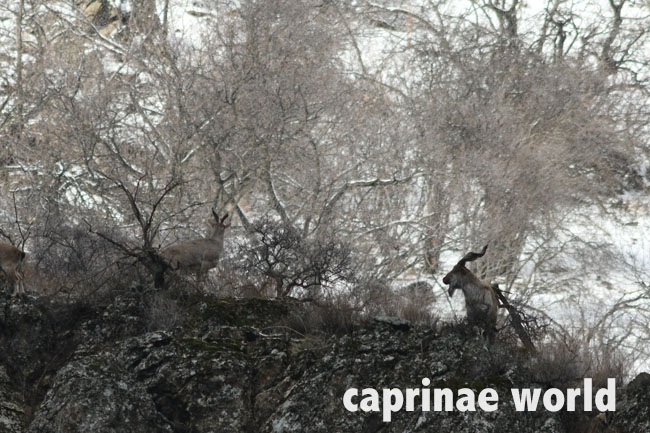
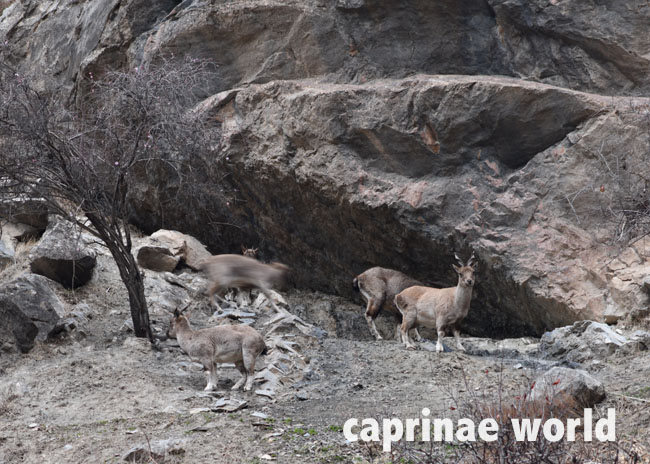
Food and feeding
In the Kugitang Mountains Markhor feed all year on grasses like meadow grass (Poa sp.), brome (Bromus sp.), sedges, Ziziphora, Turkmenistan maple, Bukhara almond, Cotoneaster, cherry, honeysuckle and the like. Of the Maksimowitschs rhubarb new shoots are eaten during spring and the dried leaves during winter. Preferably also in winter and in great quantities Artemisia is taken as well as the young needles of the Serawschan-Juniper (Juniperus serawschanica). Of old trees Markhors feed only on the thin, tender twigs. Umbellifers also have a certain importance as winter food, such as Prangos pabularia and Ferula jaeshkeana. Last year’s, yellowed herbs and grasses are usually not pawed under the snow. Instead the animals are content with herbs and grasses they find on snow-free areas, as well as with twigs. During summer they drink, in winter snow replaces water (Sultanov, 1953). [5b]
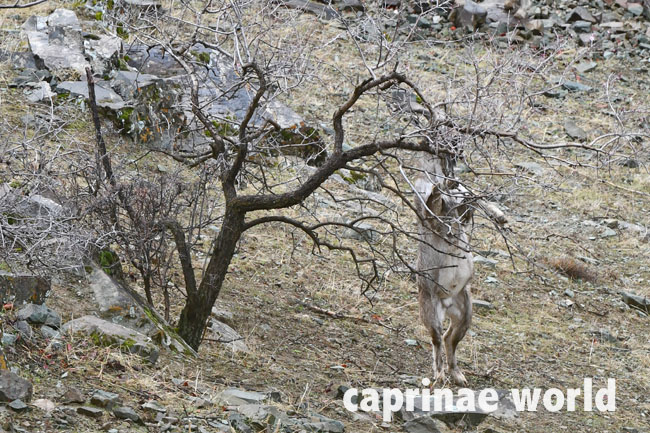
Predators / Mortality
Certain losses occur through wolves. But they are only a threat to the Markhors, when they surprise them far apart from their retreat areas. [5b]
Breeding
mating season: in the Kugitang Range during first half of November until third week in December. Males and females stay together. Up to 27 animals have been observed in the Kugitang. [5b]
gestation: almost 6 months [5b]
synchronised calving: in Kugitang end of April / beginning of May [5b]
number of young: 1-2 [5b]
point, when young is able to follow its mother: on second day [5b]
lactation: lasts until winter; sometimes 5-6 [5b]
Activity pattern
During summer Markhor from the Kugitang Range feed during the night and at dusk and dawn. Around 10 in the morning, after drinking, they retreat to shady places between rocks and bushes. At sunset they drink and then start feeding again. Open water is scarce in the Kugitang. Distances to water places sometimes exceed 1 kilometre. During winter the animals feed almost the whole day. [5b]
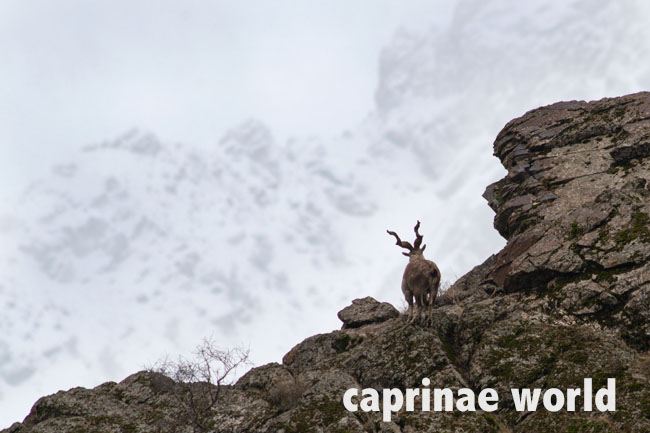
By night they retreat and seek shelter from wind (Sultanov 1953). In case of imminent danger, they retreat to cliffs. Markhor are incapable of constant running. During most time of the year males and females are separated. Young and subadult males stay with the females. The herd instinct is more distinct during winter. [5b]
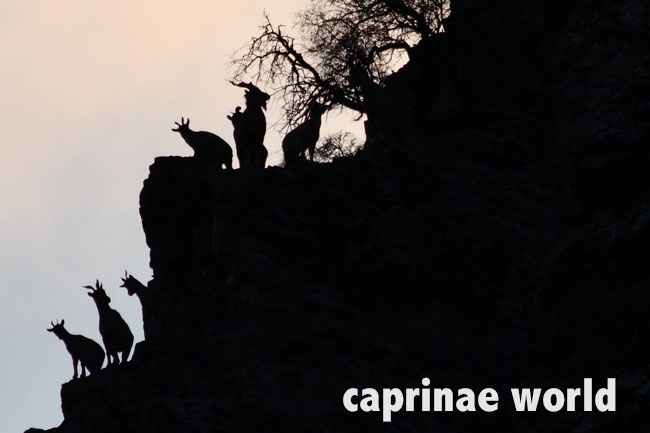
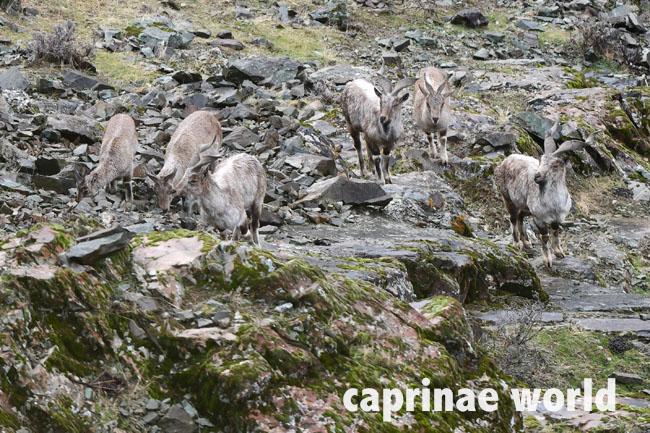
Markhors from the Kugitang make seasonal migrations. The vertical distance between summer and winter habitats can come to several 100 metres. But commonly the animals stay within the same vegetation zone of open juniper forests. Only during severe winters some animals descend to lower elevations into the steppe zone. Sometimes the animals even appear close to the settlements, below 800 m ASL (Sultanov 1953). [5b]
In the Kuljab area (Kulob, Tajikistan) seasonal migrations are more extensive. Migrations start as early as September, and females are found below the upper crop fields line. Asiatic Ibexes usually do not descend that far. Markhors stay here until spring (Trubeckoj 1910). [5b]
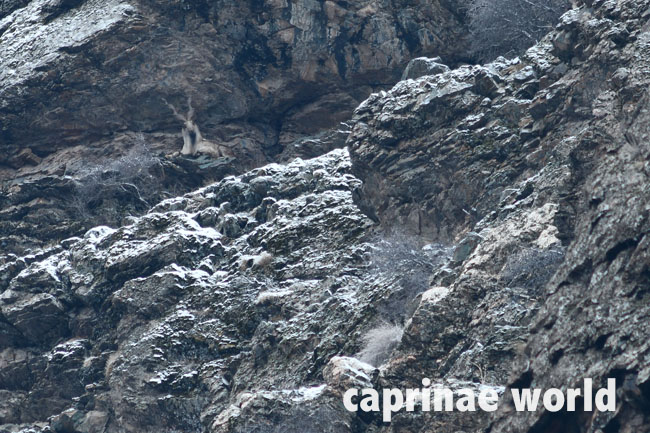
Status
WCS staff surveyed parts of the potential range of C. f. heptneri in Northern Afghanistan in 2011. Due to security problems these surveys covered only small areas. The team observed four Markhor between Payan-e Moor and Aspakha Villages in the Kohe Ghaws area of Shahr-e Buzurg in Takhar Province. Local hunters believed that there were perhaps 20 Markhor left in this area. The interviews in Shahr-e Buzurg strongly supported the historical presence of Markhor in this district: 41 informants from northern and central Shahr-e Buzurg believed that Markhor were abundant in northern Shahr-e Buzurg during the 1970s. In the area between Dahan-e Ab Kof and Leiwgard Village in the Gandamargh Valley (Kuf Ab District in Darwaz, Badakhshan Province), the team observed six Markhor. Interviews with local hunters suggested that this area held approximately 80 Markhor (Moheb and Mostafawi 2011, 2012). [6]
In the ex-Soviet republics, the total population was estimated to be about 1.000–1.200 animals in the 1970s (Zhirnov 1977), generally decreasing in the 1990s to about 700 animals (Weinberg et al. 1997a). However, Weinberg et al. (1997b), based on reports from game wardens and local inhabitants, believed the local population in Kugitang Strict Nature Reserve in eastern Turkmenistan increased during the mid-1990s. [6]
Between 1960 and 1970, Zhirnov (1977) assumed that there were approximately 1.000 Markhor in Tajikistan, with the only viable population in the Kushvariston and Hazratishoh Mountains. In contrast, Sokov (1983, quoted in Baskin and Danell 2003) assumed that in 1967 only 500 remained in Tajikistan, decreasing to 400 by 1983. During the late 1980s in the Hazratishoh Range and in Kushvariston (Tajikistan) there were around 350 Markhor (Sokov 1989). Survey data from 2008-2012 (Michel et al. 2014) indicated that the subpopulation in the Hazratishoh and Darvaz Ranges of Tajikistan was stable and likely increasing, with a total of 1.018 recorded in 2012. A survey in 2014 recorded 1.300 in these areas (Alidodov et al. 2014) In the Sarsarak Range a separate population was rediscovered in 2014, with eight Markhor counted and about 30–40 reported by local hunters (K. Karimov pers. comm. 2014). [6]
During surveys on the western (Turkmenistan) slopes of the Kugitang Range in 1995 and 2000, Weinberg et al. (1997b) and Lukarveski (2002) recorded 227 and 303 Markhor respectively. No recent information from Turkmenistan is available on the population number and trend of this subpopulation. Given the stable or slightly increasing numbers at the eastern (Uzbekistan) slope of the Kugitang Range, we assume that in Turkmenistan currently there are about 250 Markhor. [6]
In the early 1980s there were 400 Markhor in Uzbekistan according to the Red Data Book of Uzbekistan (1983), but in 1994 there were only 270-290 estimated in Uzbekistan, with only 86 counted in the Surkhan Strict Nature Reserve (western slope of Kugitang Range) in May 1993 (Chernogaev et al. 1995). Survey data by the administration of Surkhan Strict Nature Reserve suggested an increase since a low in 2003 (140-150 recorded, 160–180 guessed), reaching its maximum at 310–313 animals in 2013 (Xoliqov 2013). [6]
An educated guess, combining data from different areas, suggests that the recent (2011-2013) total population of C. f. heptneri was about 1.680 Markhor (1.008 mature individuals). [6]
Threats
In Afghanistan, interviews suggested that within Markhor range overhunting is a considerable problem, with little capacity for enforcement of the national hunting ban (Moheb and Mostafawi 2011, 2012). As a result, Markhor appear to be under threat due to unsustainable hunting. (Moheb and Mostafawi 2011, 2012) Poaching in adjacent areas of Tajikistan is reported to threaten the source population of Markhor in Shahr-e Buzurg District (Moheb and Mostafawi 2011, Michel et al. 2014). [6]
In Tajikistan, Markhor are poached for meat. There are published reports of skins and horns of about 100 poached Markhor being detected in a camp of Afghan poachers in Tajikistan (Michel 2010). According to Moheb and Mostafawi (2011), hunters in northern Shahr-e Buzurg in Afghanistan told numerous stories of groups of hunters going to Tajikistan to poach, and they showed horns and two skins said to originate from there. Because of remoteness, logistical hurdles and lack of security, the international border in this area remains difficult to control. Cross-border poaching affects the security situation for game wardens, researchers, tourists, and legal foreign hunters and thus jeopardizes the conservation of Markhor in the Dashtijum Strict Nature Reserve and adjacent areas. A recent report (Alidodov et al. 2014) suggests that in some areas poaching is mainly targeted at mature males (including illegal trophy hunting, Vaisman et al. 2014), and that there is a low proportion of adult males (4-5% of the total number, compared to above 20% in other areas). Habitat quality has deteriorated in some locations due to excessive and poorly regulated fuel wood cutting and intensive grazing. [6]
In September and October of 2010 pneumonia broke out amongst the Bukhara Markhor in Tajikistan. It is believed to have killed at least 65 animals. Mycoplasma bacteria transferred from domestic goats probably caused the outbreak. Raising goats in habitats used by Markhor is a necessity for local communities with few other livelihood options. This cohabitation increases the risk of transmissiom of infectious agents from domestic stocks to Wildlife (Ostrowski et al. 2012). [2]
In Turkmenistan, increasing grazing of goats and intense poaching threaten Markhor (Lukarevski 2002), whereas Weinberg et al. (1997b) reported that in 1995 grazing and illegal hunting seemed well controlled in Kugitang Strict Nature Reserve. [6]
In Uzbekistan, Markhor are now largely restricted to the Surkhan State Strict Nature Reserve and its buffer zone. Despite their protected status, illegal cutting of trees and shrubs, livestock grazing, and poaching were reported (UNDP 2007). No specific information on the current status of these threats is available, but recent Markhor population data (Xoliqov 2013) suggest that the threats are controlled, at least to some extent. [6]
For „Trophy hunting“, „Ecotourism“ refer to respective sections in the general Markhor introduction chapter
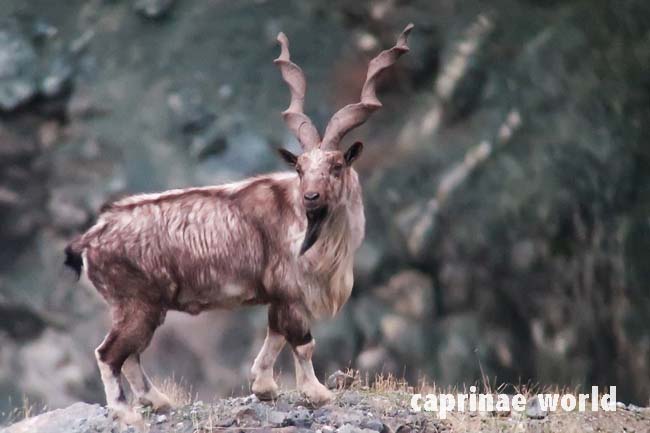
Literature cited
[1] Castelló, José R., 2016: Bovids of the World – Antelopes, Gazelles, Cattle, Goats, Sheep, and Relatives. Princeton University Press
[2] Damm, Gerhard R. and Franco, Nicolás, 2014: The CIC Caprinae Atlas of the World – CIC International Council for Game and Wildlife Conservation, Budakeszi, Hungary in cooperation with Rowland Ward Publications RSA (Pty) Ltd., Johannesburg, South Africa
[4] Groves, Colin and Grubb, Peter, 2011: Ungulate Taxonomy. The John Hopkins University Press
[5] Grzimek, Bernhard (Hrsg.), 1988: Grzimeks Enzyklopädie, Säugetiere, Band 5. Kindler Verlag, München
[5b] Heptner, V. G. and Naumov, N. P. (edit.), 1966: Die Säugetiere der Sowjetunion. Band 1: Paarhufer und Unpaarhufer. Gustav Fischer Verlag, Jena.
[6] Michel, S. & Rosen Michel, T. 2015. Capra falconeri (errata version published in 2016). The IUCN Red List of Threatened Species 2015: e.T3787A97218336. https://dx.doi.org/10.2305/IUCN.UK.2015-4.RLTS.T3787A82028427.en. Downloaded on 06 May 2020.
[7] Matschei, Christian, 2012: Böcke, Takine & Moschusochsen. Filander Verlag
[10] Schaller, George B., 1977: Mountain Monarchs – wild sheep and goats of the Himalaya. The University of Chicago Press
[16] Wilson, D. E. and Mittermeier, R. A. [eds], 2011: Handbook of the mammals of the world. Vol. 2. Hoofed mammals. Lynx Edicions, Barcelona.

